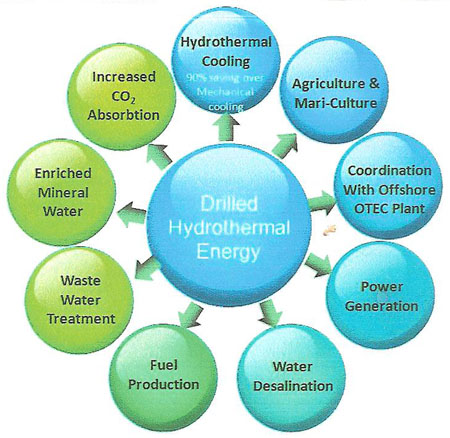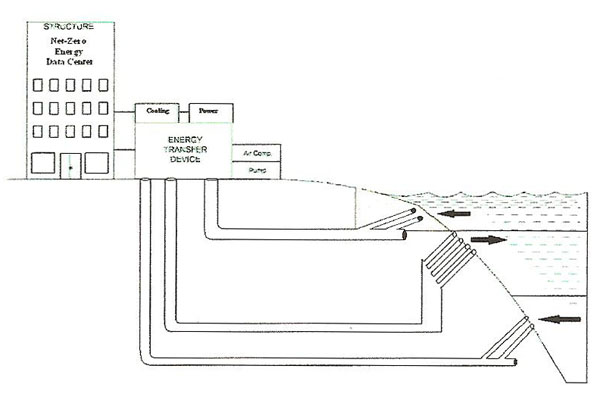drilled hydrothermal energy

Drilled hydrothermal energy.

The above illustrates the concept of using tunnel boring and directional drilling to access and discharge cold and warm seawater or lake water. As of 2010 the longest tunnel using tunnel boring machines has a horizontal reach of 35.4 miles (57 km) while directional drilling has a horizontal reach of 7 miles (11 km) and true vertical depth exceeding 1 mile (~1600 meters). This environmentally responsible method of extraction and discharge avoids disturbing coral reefs and thermal pollution, while protecting the investment from earthquakes and hurricanes. The water resources when brought to onshore wells, will be used for space cooling and process cooling saving up to 90% of the comparable mechanical cooling cost. Clean low cost electric power may be generated from the temperature difference of warm surface water and deep cold water. This power may also be dedicated to generate low cost hydrogen fuel and a host of other benefits. Upon returning the mineral rich deep water to the upper layer, ocean atmospheric carbon absorption is increased, thereby partially mitigating anthropogenic climate change.6.
Drilled hydrothermal energy is the first practical application of ocean thermal energy conversion (OTEC), also known as hydrothermal power generation. It was first conceived the French inventor Georges Claude, who was enthralled with the potential of ocean energy. In 1929, he convinced Cuban dictator, Gerardo Machado, to build ocean thermal power plants that "could light up not only the entire island and its new industry but also deliver surplus power to Florida by undersea cable".1 Matanzas Bay, Cuba, was selected for its relatively close proximity to cold and warm water.
The success of producing power in 1930 was preceded by three previous attempts that resulted in the complete loss of the investment of pipe. These mishaps highlight the precarious nature of laying pipes in the ocean. In the latter part of the last century, Makai Engineering of Hawaii devised a controlled submergence method of deploying pipes. Projects at the Natural Energy Laboratory in Hawaii, NELHA, as well as the lake source cooling projects in Toronto, Canada, and Cornell University, in New York, proved the viability of this method with respect to hydrothermal cooling.2 The NELHA project, however, exposed a possible flaw for laying pipes for intakes. After a 2006 earthquake, the polymer pipe cracked at the elbow of the seawater-to-earth junction of the cold water intake. This allowed warm water to enter the intake pipe compromising a cooling or ORC system. The junction was later repaired, but the event pointed out the need for a more robust solution. In addition, a US Department of Energy report to the US Congress in 2009 highlighted environmental concerns of an assortment of ocean energy technologies and suggested various mitigations. For ocean thermal resources, one concern was the laying of cables or pipes on sensitive sea floor environments. Thermal pollution was yet another concern. In the former case, the mitigation of using horizontal directional drilling was suggested.3
In a joint UNEP-ASHRAE conference in Cairo, Egypt, in September 2010, an idea was introduced to mitigate the aforementioned concerns and mishaps of past applications by erecting drilled hydrothermal cooling plants.2 This concept adopts mature technologies from other industries and applies them to hydrothermal energy. For instance, the process of applying tunnel boring machines to create hydro tunnels is used in the hydroelectric industry. The process of directional drilling, and more specifically extended reach drilling, is used extensively in the petroleum industry.
Not only do these techniques resolve the risks involved when submerging pipes, but the drilled conduits, unlike exposed pipes, also protect the conduits from violent ocean currents. An exposed pipe must transition from the earth to the open water underneath the shore break. During an earthquake, the pipe may be exposed to different stress levels, particularly at the junction. Provided that a drilled conduit does not cross a fault, during an earthquake the pipe should move together with the surrounding rock encasement thereby decreasing the conduit's vulnerability.
A presentation made at the 2010 Sustainable Florida Conference4 suggests that there are at least nine potential benefits from a comprehensive application of drilled hydrothermal energy. The figure at the upper right from that presentation depicts those benefits. One suggested practical application is to combine the cooling benefit with power generation to create Net Zero Energy Data Centers which would be totally off the grid while promoting atmospheric carbon absorption. See the figure below.
The abundance of this renewable energy source was testified by ocean energy scientist Hans Krock:
The energy flowing through the surface layer of the tropical ocean is about 10,000 times greater than the energy used by human societies. As such it is the only energy resource on earth that is large enough to replace fossil fuel.7While drilled hydrothermal energy plants are still conceptual in 2011, perhaps a path is illuminated stretching beyond the hydrocarbon era.
References
1.Chiles,
James R. "The Other Renewable Energy." Invention & Technology,
Winter 2009.
2. Jagusztyn, Tadeusz F. and Reny, Marie (2010) "Natural Cold Water District
Cooling Plants Enabled by Directional Drilling" Road to Climate Friendly
Chillers UNEP – ASHRAE Conference, Sept 2010, Cairo, Egypt.
3. DOE
2009. Report to Congress on the Potential Environmental Effects of Marine
and Hydrokinetic Energy Technologies. December 2009, Pg. 23, 43-46
4. Jagusztyn,
Ted. "Natural Cold Water District Cooling Plants Enabled by Directional
Drilling", Presentation at the Sustainable Florida Conference –
Collins Center, October 13, 2010 Palm Beach Gardens, Florida
5. Jagusztyn, Tadeusz (Ted)., (2011) "The Prospect of Hydrothermal Net-Zero
Energy Data Centers" Peer reviewed accepted paper submission 7709 – ASHRAE Winter Conference, Jan 2012, Chicago
6. Crews,
Richard. "OTEC Sites." Aquarius Rising Maldives – An Ocean Research
Centre and Eco-tourist Facility. 28 Dec.1997. Web. 13 June 2010.
7, Krock,
Hans. Testimony of Hans Krock re: Ocean Thermal Energy Conversion (OTEC)
LOL T-9 Public Utilities Commission Docket No. 05-0145 O'ahu Power Plant.
Pg. 4
